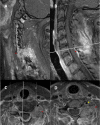Tenosynovial Giant Cell Tumor of the Cervical Spine: Case Report and Review of the Literature
- PMID: 33505809
- PMCID: PMC7821702
- DOI: 10.7759/cureus.12232
Tenosynovial Giant Cell Tumor of the Cervical Spine: Case Report and Review of the Literature
Abstract
Tenosynovial giant cell tumor (TGCT) is a rare entity that is not well described in the neurosurgical literature. We present a case of a 37-year-old woman with a diffuse subtype TGCT of the cervical spine, affecting the left cervical 6-7 facet joint, with co-incidental cervical trauma. Initial management consisted of subtotal resection and cervical stabilization with cervical 6 to 7 laminectomy, and cervical 4 to thoracic 2 posterior instrumented fusion. Gross total resection was achieved at a later date with a plan for postoperative radiation to prevent a recurrence. The patient was lost to follow-up for radiation treatment and returned 2.5 years later with minor symptoms and recurrence at the surgical site.
Keywords: cervical spine; diffuse type; giant cell tumor; spine oncology; tenosynovial; trauma.
Copyright © 2020, Thatikunta et al.
Conflict of interest statement
The authors have declared that no competing interests exist.
Figures





References
-
- Pigmented villonodular synovitis, bursitis and tenosynovitis. Jaffe HL. https://ci.nii.ac.jp/naid/10024754960/#cit Arch Pathol. 1941;31:731–765.
-
- Pigmented villonodular synovitis and giant cell tumors of the tendon sheath: radiologic and pathologic features. Llauger J, Palmer J, Rosón N, Cremades R, Bagué S. AJR Am J Roentgenol. 1999;172:1087–1091. - PubMed
-
- Pigmented villonodular synovitis of the spine: a clinical, radiological, and morphological study of 12 cases. Giannini C, Scheithauer BW, Wenger DE, Unni KK. J Neurosurg. 1996;84:592–597. - PubMed
-
- C1-C2 pigmented villonodular synovitis and clear cell carcinoma: unexpected presentation of a rare disease and a review of the literature. Lavrador JP, Oliveira E, Gil N, Francisco AF, Livraghi S. Eur Spine J. 2015;24:0. - PubMed
Publication types
LinkOut - more resources
Full Text Sources
